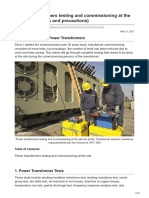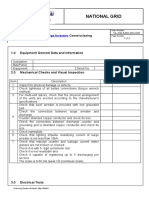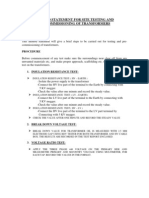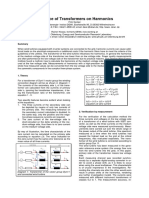Transformer
Transformer
Uploaded by
rasheed313Copyright:
Available Formats
Transformer
Transformer
Uploaded by
rasheed313Original Description:
Copyright
Available Formats
Share this document
Did you find this document useful?
Is this content inappropriate?
Copyright:
Available Formats
Transformer
Transformer
Uploaded by
rasheed313Copyright:
Available Formats
A NOVEL METHOD TO MEASURE RATIO AND NON-STANDARD PHASE DISPLACEMENTS OF SPECIAL TRANSFORMERS USING A SINGLEPHASE SUPPLY AND MERITS
OF USING HIGHER TEST VOLTAGE
R. Kuppuswamy and R. Schomper Haefely Test AG, Lehenmattstrasse 353 Basel, Switzerland Email: <schomper.richard@haefely.com>
Abstract: Three-phase voltage supplies together with phase vector meters have been traditionally used for measuring voltage ratio of transformers having non-standard phase displacements. Non-standard phase displacements refer to phase-shifts that do not follow 30 clock steps (example, -7.5, 22.5, etc). Some examples being: phase-shifters, rectifier, arc-furnace, quad-boosters and traction transformers. In the new method, instead of using a 3-phase voltage supply, 3-phase equivalent voltages are simulated at different terminals of a transformer by energising a pair of the terminals and interconnecting certain other terminals in a custom defined manner to generate the necessary 3-phase equivalent voltages. This permits determination of the ratio and phase displacement using common ratio bridges, which use single-phase voltage supplies. In the first part of the paper, theoretical background of this method and results obtained from the field to validate this approach are presented. In the second part of the paper, it is shown analytically as to how the test voltage level can affect the flux distribution in the transformer and ultimately the measured ratio accuracy. This is followed by a presentation of a few field results to show how the test voltage plays a significant role on the measurement accuracy, which hitherto is unknown to many in the industry.
Introduction Transformer ratio measurement is one of the frequently used tests in the industry as a part of the factory acceptance tests mandated in the standards, before the transformer is put to service and as a valuable diagnostic test. Ratio and phase displacement measurements of special transformers having non-standard phasedisplacements have been traditionally practised by using either a cumbersome combination of three phase voltage source and phase vector meter or a specially designed three-phase ratio bridge. Both these solutions necessitate the use of a threephase AC voltage supply or 1-phase to 3-phase voltage supply converter. Having the necessity for a 3-phase supply is disadvantageous because it is usually difficult to source one during field tests. The solution with an additional kit to generate 3-phase supply from a 1-phase source means extra hardware and is equally inconvenient. In the first part of this paper, an alternate approach of achieving the ratio and non-standard phase displacement using a single-phase 90-265V supply is described. This discussion starts with the basic principle of working of a single-phase ratio bridge, the conditions that need to be satisfied for the principle to work and why the standard technique is insufficient when non-standard phasedisplacements have to be measured. This is followed by an elaboration of the theoretical basis
of the new method and field measurement results of some representative special type transformers. The second part of the paper is about how the test voltage used for ratio measurements on large power transformer plays a significant role on the measured accuracy, which is unknown to many in the industry. The IEEE standard [1] states that when rated voltage is applied to one winding of the transformer, all other rated voltages at no load shall be correct within one half of one percent (+ 0.5%) of the nameplate readings Similar requirements are spelt out in the IEC 60076-1 standard [2]. Over the years, some of our customers have reported that for large power transformers (> 100 MVA) where use of tertiary windings is either mandatory or prevalent, using a higher test voltage leads to a better accuracy in the ratio results. Upon further investigations and several field measurements at large power transformer test laboratories, the findings were that higher test voltage indeed leads to a better accuracy and has a technical basis as explained later in this document. During the period of our field investigations at large power transformer factories, there were few instances of transformers with a tertiary winding failing to meet the + 0.5% tolerance, if tested at 100 V and the same tested at a higher voltage
(250 V [3]) gives a result within the tolerance limit prescribed in the standards. Some transformer manufacturers, who were aware of this phenomenon, practised a combination of 3phase excitation voltage and an arrangement of 2 to 6 multi-meters connected to different transformer bushing terminals to simultaneously read the voltages of several multi-meters and calculate the ratio. The accuracy of this method depended on how accurately the multi-meters were synchronized with each other and the measurement accuracy of the used meters. Finally at the end of the second part of this paper, directly after the analytical explanation as to how the test voltage level affects the measured ratio accuracy, a presentation of several field results is given to show how the test voltage plays a significant role on the measurement accuracy, which hitherto is unknown to many in the industry.
1.2 Conditions imposed by the classical single-phase ratio bridge Turns ratio measurement of a three-phase transformer using the classical single-phase ratio bridge is possible only if the following conditions are met: 1. The applied magnetic flux should link all the windings, winding segments and their combinations. 2. All necessary winding terminals should be available externally either for measurement or interconnection. 3. External interconnections dont lead to short circuits with internal bridge terminals.
1.3
Limitations of classical single-phase ratio bridge
1 RATIO AND ANGLE MEASUREMENT OF TRANSFORMERS HAVING NON-STANDARD PHASE-ANGLES 1.1 Basic working principle of a single-phase ratio bridge. The basic working principle of single-phase ratio meters is illustrated in figure 1.
An example case, of a locomotive transformer having arbitrary phase shift is illustrated in figure 3. This represents a case where the classical singlephase ratio bridge cannot be used, as it does not meet all the conditions elaborated in the preceding section. 1. In the example shown, all the windings are linked by the same magnetic flux (through the core). 2. In the example shown, for turns ratio measurements between the primary and secondary winding, terminals 2U, 2V, 2W and 3U, 3V and 3W are not externally accessible. 3. Some external interconnections lead to shortcircuit with the internal terminals of the bridge.
1U T
G
2U
R1 R
1N
2N
Fig. 1: Simplified illustration of a 1-ph ratio bridge
The high and low voltage windings are connected in phase opposition by decade resistances (for the case shown) and voltages are compensated. When the bridge is balanced, the load on the transformer is either very light or negligible and the turns ratio equals U2U-2N / U1U-1N.
Fig. 2: Locomotive Transformer having vector group Dd11.75d0.75
1.4 New Method In the alternate approach, instead of using a 3phase supply, 3-phase-equivalent voltages are simulated at different terminals of the transformer by energising a pair of the terminals and interconnecting certain other terminals in a custom defined manner to generate the necessary 3phase equivalent voltages. This permits determination of the ratio and phase displacement using a classical single-phase ratio bridge.
1.5 Measurements on a phase-angle controlled 240MVA 220/115kV Auto-transformer This is an example of a special transformer, where the power transfer is regulated by changing both the ratio and phase-angle. In contrast to quadboosters where the winding pair is in phasequadrature and fixed, here it is at an angle, so the power transfer involves both ratio and angle changes. Furthermore, the angles at both the extreme tap positions do not have the same value. Table 1 below summarizes the design values of ratio and phase-displacements for different tap positions. As, can be seen the phase-angle ranges between -8.03 to +6.92.
Table 1
B U x A a z c W C r1 y r2 b R V
Tap 1 8 17 18 19 33
HV nom LV nom Design Values (kV) (kV) Ratio Angle, (deg) retard 238.220 115 2.0715 6.92 retard 229.844 115 1.9990 4.03 mid 220.000 115 1.9130 0 advance 218.976 115 1.9041 -0.47 advance 217.967 115 1.8954 -0.94 advance 205.497 115 1.7869 -8.03
The measured values of the ratio and phase angle at a test voltage of 250V are shown in Table 2. The ratio and phase deviations are respectively less than +/- 0.14% and +/- 0.05.
Table 2
Fig. 3: Illustration of the alternate approach For a symmetric 3-ph system,
U = A B = V = BC = W = C A
and
Phase A Tap 1 8 17 18 19 33 Phase B Tap 1 8 17 18 19 33 Phase C Tap 1 8 17 18 19 33
Design Ratio Angle, deg. 2.0715 6.92 1.9990 4.03 1.9130 0 1.9041 -0.47 1.8954 -0.94 1.7869 -8.03 Design Ratio Angle, deg. 2.0715 6.92 1.9990 4.03 1.9130 0 1.9041 -0.47 1.8954 -0.94 1.7869 -8.03 Design Ratio Angle, deg. 2.0715 6.92 1.9990 4.03 1.9130 0 1.9041 -0.47 1.8954 -0.94 1.7869 -8.03
Measured Ratio Angle, deg. 2.0711 6.90 2.0006 4.06 1.9128 0.05 1.9024 -0.49 1.8948 -0.98 1.7848 -8.07 Measured Ratio Angle, deg. 2.0739 6.90 2.0000 4.06 1.9145 0.05 1.9062 -0.49 1.8961 -0.98 1.7872 -8.07 Measured Ratio Angle, deg. 2.0719 6.90 2.0001 4.06 1.9117 0.05 1.9014 -0.49 1.8958 -0.98 1.7853 -8.07
Deviation Ratio Angle, deg 0.02 -0.02 -0.08 -0.03 0.01 +0.05 0.09 -0.02 0.03 -0.04 0.12 -0.04 Deviation Ratio Angle, deg -0.12 -0.02 -0.05 -0.03 -0.08 +0.05 -0.11 -0.02 -0.04 -0.04 -0.02 -0.04 Deviation Ratio Angle, deg -0.02 -0.02 -0.06 -0.03 0.07 +0.05 0.14 -0.02 -0.02 -0.04 0.09 -0.04
x = ab = y = bc = z = ca
with 1-phase measurements, where B and C are short-circuited and the voltage is applied between A-[B-C], then following 3-phase equivalent voltages are generated.
U =
R cos
x =
r2 cos 6
z =
r1 cos + 6
U
Ratio =
U z
2 INFLUENCE OF TEST VOLTAGE ON RATIO MEASUREMENT ACCURACY 2.1 Analytical Explanation Why higher test voltage is needed for accurately measuring the voltage/turns ratio of a large transformer is analytically explained hereafter. In the derivation that follows, consider the case of a three winding transformer with a delta connected tertiary. Figure 4 shows a simplified dimensional representation of a three-winding transformer. The middle-limb has been omitted for simplicity. The winding close to the iron-core is the tertiary winding, the middle winding and the outermost is the high voltage winding. Two Leakage fluxes - 1, 2 and mutual fluxes 21, 12 are shown respectively as closely spaced (red) and widely spaced (blue) dotted lines. Assume that the transformer has a core of magnetic material whose permeability is constant. With this assumption, the principle of superposition can be applied, and the resultant flux linking each winding can be expressed as the sum of the components due to each current acting on its own. These components are: 1. The leakage flux due to the current in the winding 2. The component mutual flux due to the current in the winding; 3. The component mutual flux due to the current in the other winding. Thus the resultant flux, 1 and 2, for each of the winding-pair tested, can be expressed as
The fluxes with double subscripts are the components produced by a single current acting by itself. That is, 1 and 2 are the component leakage fluxes produced by each current; 21 is the component mutual flux produced by current in winding, I1 and 12 is the component mutual flux produced by I2. The transformer voltage equations become
V1 = R1 I 1 + N 1
d 1 d 12 + N1 dt dt
For Winding 1, Eq. 3
V2 = R2 I 2 + N 2
d 2 d 21 + N2 dt dt
For Winding 2, Eq. 4
Each terminal voltage is thus expressed as the sum of a resistance drop, a voltage induced by leakage flux, and a voltage induced by the resultant mutual flux.. The component leakage fluxes 1and 2 induce voltages in only the winding with which each is associated, but the resultant mutual flux 21 or 12 links both windings and induces in them voltages whose ratio equals the turns ratio, as in an ideal transformer. During a ratio test, only a pair of the winding is tested and the winding that is excited is the one with a higher voltage rating than the other. For example if the winding pair tested is high voltage (HV): tertiary (TV), the test voltage is applied to the HV winding as it is the higher in voltage class than the other. This is done to prevent the generation of dangerously high voltages in the measured winding, which is connected to the ratio meter. The amount of flux transferred from the excited to the measured winding and the core depends on the physical location of the excited winding with respect to the measured winding and the iron core. During a voltage ratio test, the voltage across the winding 1 (1) is fixed and 2 is measured. It follows from Eq. 4 that 2 is largely a function of the mutual flux (12, 21). Higher test voltage leads to the generation of higher excitation current, resulting in more flux in the excited winding (HV winding in our example) and a corresponding increase in the component flux levels, 2 and 21. Consequently this leads to an increase in the measured value of 2 and a corresponding decrease in the estimated value of the voltage ratio (1 / 2 ). This drop in the ratio value is slight and subtle. The component flux that makes this difference is largely due to the mutual flux 21 and to a limited extent by the leakage flux (2). The role of the
Eq. 1
1 = 1 + 21 + 12
Winding 1 is usually either the primary or the secondary of a 3 winding transformer
Eq. 2
2 = 2 + 12 + 21
Winding 2 is usually the tertiary winding.
21 12 1 2
Fig. 4. Flux distribution in a transformer.
mutual flux (21) is governing because its coupling is affected by the physical size of the winding pair tested and their proximity to each other. In simple terms, this means that the ratio accuracy is more affected between the winding pair HV: tertiary than HV: middle-winding. There may be however some exceptions. The role of 2 is limited because its increase or decrease is proportional to the current flowing in the measured winding, i2 (=i1* N1/N2). In other words, the increase in the test voltage leads to a proportional increase in the value of 2 and thus is not a factor in the estimated value of the voltage ratio. This trend in drop in the ratio values at higher test voltages is almost always seen in the field results, thereby confirming that at a higher excitation voltage the mutual flux coupling is more representative of a real situation and thus the reason behind the improvement in the ratio measurement accuracy. 2.1 Ratio measurements on a 275/132/33 kV, 240 MVA Test Transformers The influence of the test voltage is demonstrated on a three phase auto transformer of following name plate rating: 275/132/33 kV 240 MVA using two methods: (a) combination of 3-ph voltage source and 6 multi-meters synchronised to each other and (b) using a 250V TTR. The ratio was measured between the 275 kV (HV) and 33 kV (tertiary) winding. The results of the measurements are presented in Table 3 and in figures 5 and 6. As can be seen from the results, the drop in ratio deviation is quite steep at test voltages below 150V and then slowly flattening out at higher test voltage levels. Table 3:
0.450 0.350 0.250 0.150 0.050 0.050 0 100 200 300 400 500 PhaseA PhaseC PhaseB
Figure 5: Variation of ratio deviation with test voltage. Measuring device combination of threephase voltage source and six multi-meters synchronised with each other. X-axis: test voltage in volts and Y-axis: ratio deviation.
0.450 0.350 0.250 0.150 0.050 0.050 0 50 100 150 200 250 300 PhaseA PhaseC PhaseB
Figure 6: Variation of ratio deviation with test voltage. Measuring device 250 V single-phase ratio bridge. X-axis: test voltage in volts and Y-axis: ratio deviation
Utest[V] 20 30 40 50 60 70 80 90 100 150 200 250 300 350 400 450
calculated ratio 4.8113 4.8113 4.8113 4.8113 4.8113 4.8113 4.8113 4.8113 4.8113 4.8113 4.8113 4.8113 4.8113 4.8113 4.8113 4.8113
MeasurementSetup:Combinationof3phsourceand6multimeters BN/3B3C CN/3C3A AN/3A3B measured deviation measured deviation measured deviation ratio [%] ratio [%] ratio [%] 4.8242 0.269 4.8302 0.393 4.8309 0.408 4.8226 0.235 4.8257 0.300 4.8271 0.330 4.8203 0.187 4.8235 0.254 4.8245 0.275 4.8180 0.139 4.8214 0.210 4.8224 0.231 4.8167 0.113 4.8207 0.196 4.8214 0.211 4.8164 0.108 4.8202 0.187 4.8206 0.194 4.8167 0.113 4.8210 0.203 4.8216 0.215 4.8163 0.106 4.8201 0.183 4.8205 0.193 4.8152 0.083 4.8181 0.142 4.8202 0.186 4.8131 0.039 4.8162 0.103 4.8182 0.144 4.8116 0.007 4.8149 0.077 4.8167 0.112 4.8120 0.016 4.8155 0.088 4.8167 0.112 4.8124 0.023 4.8154 0.085 4.8171 0.122 4.8113 0.001 4.8147 0.071 4.8159 0.098 4.8111 0.004 4.8146 0.069 4.8158 0.094 4.8107 0.011 4.8139 0.055 4.8153 0.084
250VTTR 'A'dev. [%] 0.220 'B'dev. [%] 0.240 'C'dev. [%] 0.340
0.050
0.120
0.160
0.010
0.070
0.090
Furthermore, the accuracy with the 250V TTR is better than the one using a combination of threephase source and several multi-meters. 2.2 Ratio measurements on a 464/100/30 kV, 350 MVA Transformer Figure 7 graphically summarises the results of the ratio measurement on a 464/100/30 kV, 350 MVA transformer having vector group YNyn0d5. Voltage ratio was measured between the 464 and 30kV winding.
measured winding (TV) is reduced, when there is an intermediate winding between HV and TV. 3 Conclusions
In the first-part of the paper an alternate approach to measure the turns ratio and phase angle of special type transformers that do not follow 30 clock shifts using a single phase voltage supply was presented. The measured phase angle accuracy was also shown to be better than the classical combination of three-phase voltage supply and phase vector meter. In the second-part of the paper, the reason for the higher test voltage leading to a higher measured accuracy on large power transformers with tertiary winding was analytically explained. The influence of the test voltage on the measurement accuracy was demonstrated by presenting results from transformers having ratings between 240 and 600 MVA. Measurements with the 250V TTR gave an accuracy that was better than a traditional combination of three-phase voltage supply and several multi-meters synchronised to each other.
0.90 Ratio Error (%) 0.70 0.50 0.30 0.10 25 V 100 V Test Voltage 250 V
0.5% accuracy limit
Fig. 7: Ratio Measurement results of tests on a 350MVA transformer. 2.3 Ratio measurements on a 388/240/21 kV, 600 MVA Transformer Figure 8 graphically summarises the results of the ratio measurement on a 388/240/21 kV, 600 MVA transformer having vector group YNyn0d11. The accuracy of measurements between the HV (338 kV) and tertiary (21 kV) winding at test voltage levels 2, 25, 100 and 250 volts were respectively 1.47%, 1.09%, 0.48% and 0.23%. The ratio measurement accuracy is barely met at 100V.
References
1. IEEE C57.12.00, clause 9 (2000); General Requirements for Liquid-Immersed Distribution, Power and Regulating Transformers. 2. IEC 60076-1, clause 9 (2000); Power Transformers Part I: General. 3. Operating Instructions TTR2796 V.1 05-2011, Haefely Test AG.
1.60% 1.40% 1.20%
600 MVA primary - secondary 600 MVA primary - tertiary 600 MVA secondary - tertiary
RatioError
1.00% 0.80% 0.60% 0.40% 0.20% 0.00% 2V
0.5 % accuracy limit
25V
100V
250V
Testvoltage
Fig. 8: Ratio Measurement results on a 600MVA transformer As can be clearly seen the influence of the test voltage on the accuracy is greatly felt by this winding pair high voltage: tertiary. As explained in section 2.1, the amount of mutual flux transferred from the excited winding (HV) to the
You might also like
- Relay Setting CalculationDocument3 pagesRelay Setting CalculationSamarendu Baul90% (30)
- Transformer Winding ResistanceDocument20 pagesTransformer Winding Resistancekajale.shrikantNo ratings yet
- Actom Hve Ctb36 Outdoor Circuit Breakers Aug 2018 LRDocument6 pagesActom Hve Ctb36 Outdoor Circuit Breakers Aug 2018 LRGary FortuinNo ratings yet
- Civil Design and Construction of 132kv 66kV and 33kV SubstationDocument31 pagesCivil Design and Construction of 132kv 66kV and 33kV SubstationJohn John Pechjhon100% (7)
- 1030365248421-Mvap en 0899Document4 pages1030365248421-Mvap en 0899Stone123456789No ratings yet
- Scope of WorkDocument3 pagesScope of WorkShah Aizat RazaliNo ratings yet
- Checklist-CB TestingDocument5 pagesChecklist-CB TestingMiguel Marques100% (1)
- IEC GOOSE (Generic Object Oriented Substation Events) Messaging ImplementationDocument7 pagesIEC GOOSE (Generic Object Oriented Substation Events) Messaging Implementationrasheed313No ratings yet
- Testing Tap Changers: by Michael Krüger, OMICRON Electronics AustriaDocument2 pagesTesting Tap Changers: by Michael Krüger, OMICRON Electronics AustriaFasil ParuvanathNo ratings yet
- Power Transformers Testing and Commissioning at The Site Instructions and PrecautionsDocument16 pagesPower Transformers Testing and Commissioning at The Site Instructions and Precautionszhangzuxun0413No ratings yet
- Transformer Bushings, Type GOH: Installation and Maintenance GuideDocument20 pagesTransformer Bushings, Type GOH: Installation and Maintenance Guidejtcool74No ratings yet
- CT of AcdbDocument3 pagesCT of Acdbmaheshknm100% (1)
- Aac Wasp (Insulated) ConductorDocument3 pagesAac Wasp (Insulated) ConductorjamilNo ratings yet
- Erection Procedure For Control Battery - LatestDocument12 pagesErection Procedure For Control Battery - LatestAnmohieyNo ratings yet
- Testing Procedures: CT Test FormatDocument2 pagesTesting Procedures: CT Test FormatEngr Zainulabidin KaimkhaniNo ratings yet
- Cpr-3 - Catalouge Rele RubberDocument2 pagesCpr-3 - Catalouge Rele Rubbermanuel100% (1)
- Lightning Arrester 1. GeneralDocument3 pagesLightning Arrester 1. Generaljkhan_724384No ratings yet
- SP0407C01 HV Cable Commissioning Test ReportDocument2 pagesSP0407C01 HV Cable Commissioning Test Reportkajale.shrikantNo ratings yet
- Testing of TransformersDocument45 pagesTesting of TransformersBalusamy100% (1)
- EDOC-Transformer Diagnostics and Condition AssessmentDocument16 pagesEDOC-Transformer Diagnostics and Condition AssessmentEl Comedor BenedictNo ratings yet
- Transformer Testing: Type Test of TransformerDocument9 pagesTransformer Testing: Type Test of TransformerSanjeev Dhariwal100% (2)
- How To Use A Megger Insulation TesterDocument2 pagesHow To Use A Megger Insulation TesterRakesh Babu0% (1)
- 132kv VT TestDocument2 pages132kv VT TestTota KamelNo ratings yet
- XLPE UGC Withstand TestDocument6 pagesXLPE UGC Withstand TestFuad BurhaniNo ratings yet
- CL-NG-6460-0002-020 Checklist For Surge Arrester Rev00Document3 pagesCL-NG-6460-0002-020 Checklist For Surge Arrester Rev00NaveenNavabNo ratings yet
- 002 LD SD 02Document11 pages002 LD SD 02marab12No ratings yet
- BAUR High Voltage Testing and Diagnostics Unit: Viola, Viola TDDocument2 pagesBAUR High Voltage Testing and Diagnostics Unit: Viola, Viola TDNOWFALNo ratings yet
- Narrative Report TransformerDocument6 pagesNarrative Report TransformerMarvin GagarinNo ratings yet
- Execution of Hydro Power Plant - PLANNING AND OPERATIONDocument49 pagesExecution of Hydro Power Plant - PLANNING AND OPERATIONkapolaNo ratings yet
- Field Visits PDFDocument7 pagesField Visits PDFAdarsh ShettyNo ratings yet
- LPDB Commissioning Protocol: 1. Pre Commissioning ChecksDocument3 pagesLPDB Commissioning Protocol: 1. Pre Commissioning Checkseswaran005No ratings yet
- Certificate of Calibration and Conformance: OmicronDocument1 pageCertificate of Calibration and Conformance: OmicronNadiaNo ratings yet
- Importance of HIPOT Testing: Dielectric Withstand TestDocument6 pagesImportance of HIPOT Testing: Dielectric Withstand TestelsayedNo ratings yet
- Bus Post Insulator InstallationDocument1 pageBus Post Insulator InstallationsantoshkumarNo ratings yet
- MS of 220 KV Switchyard EquipmentDocument8 pagesMS of 220 KV Switchyard EquipmentFareh KhanNo ratings yet
- CT Operating InstructionsDocument15 pagesCT Operating InstructionsHasbi FitrandaNo ratings yet
- 22kV GIS Cable Terminal - Installation ManualDocument11 pages22kV GIS Cable Terminal - Installation ManualNorma RetamozoNo ratings yet
- NGR Installation GuideDocument10 pagesNGR Installation Guidemartins73100% (1)
- Measurement of Insulation Resistance IR Part 2Document12 pagesMeasurement of Insulation Resistance IR Part 24843079No ratings yet
- Gas Insulated Switchgear (GIS)Document43 pagesGas Insulated Switchgear (GIS)Mahmoud MoezNo ratings yet
- DC HipotDocument4 pagesDC HipotlrpatraNo ratings yet
- Difference Between AC and DC Hi PotDocument1 pageDifference Between AC and DC Hi Potunnikrish05No ratings yet
- S.NO. Equipment Details Test Details List of Pre-Commissioning Tests of Ac EquipmentsDocument5 pagesS.NO. Equipment Details Test Details List of Pre-Commissioning Tests of Ac EquipmentsnagarajanNo ratings yet
- Minipurge Type X / Et Size 1 Manual ML 442: ML 442 V15 26-Nov-14 Page 1 of 23Document36 pagesMinipurge Type X / Et Size 1 Manual ML 442: ML 442 V15 26-Nov-14 Page 1 of 23ratheeshkumardNo ratings yet
- Site Testing Pre Commissioning PDFDocument2 pagesSite Testing Pre Commissioning PDFadi nugroho100% (1)
- Aux Transformer TestDocument4 pagesAux Transformer TestEngr Fahimuddin QureshiNo ratings yet
- CHAPTER 4 (Substations)Document15 pagesCHAPTER 4 (Substations)Dobgima LangsiNo ratings yet
- 415v Air Circuit Breaker-14Document2 pages415v Air Circuit Breaker-14Subhransu MohapatraNo ratings yet
- SIEMENS 33 KV GIS ManualDocument68 pagesSIEMENS 33 KV GIS ManualAnonymous kielG2No ratings yet
- RSC Electrical SafetyDocument15 pagesRSC Electrical SafetyEftakher Alam WasiNo ratings yet
- Company, Inc.: 3-038R-R303 SF Multifunction AnalyzerDocument1 pageCompany, Inc.: 3-038R-R303 SF Multifunction AnalyzerHamdan IskandarNo ratings yet
- Testing Procedure For Earth Leakage RelayDocument1 pageTesting Procedure For Earth Leakage RelaySujintharan Nair100% (2)
- Safe Ring Switchgear Test: A. Mechanical Check and Visual InspectionDocument2 pagesSafe Ring Switchgear Test: A. Mechanical Check and Visual InspectionyazensalehNo ratings yet
- 1.0 Oil Type Rectifier Transformer: 1.1 Standards and CodesDocument12 pages1.0 Oil Type Rectifier Transformer: 1.1 Standards and CodeskahonarehaNo ratings yet
- Testing and Commissioning ProceduresDocument8 pagesTesting and Commissioning Proceduresbhukya lachiramNo ratings yet
- Method of Statement Transformer Maintenance Scanned PDF FreeDocument48 pagesMethod of Statement Transformer Maintenance Scanned PDF FreeYOGESHWARAN RAMANATHANNo ratings yet
- Erection Procedure For Power TransformerDocument3 pagesErection Procedure For Power TransformerWaqar Ali Sher100% (1)
- Testing & Maintenance of Transformers: Listing Type Test, Routine Test & Special Test As Per I.S. 2026-1981Document14 pagesTesting & Maintenance of Transformers: Listing Type Test, Routine Test & Special Test As Per I.S. 2026-1981PKNo ratings yet
- Substation EarthingDocument5 pagesSubstation EarthingMidhun VargheseNo ratings yet
- Inspection and Test Plan (Quality - Plan) : Product Type: Medium Voltage - Manufacturer: P.T. Siemens IndonesiaDocument6 pagesInspection and Test Plan (Quality - Plan) : Product Type: Medium Voltage - Manufacturer: P.T. Siemens IndonesiavinodNo ratings yet
- Influence of Transformers On Harmonics: Equation (1) Dyn5Document4 pagesInfluence of Transformers On Harmonics: Equation (1) Dyn5EBENo ratings yet
- A Basic Description of Transformer TestsDocument8 pagesA Basic Description of Transformer Testsyeoj_aromNo ratings yet
- Zero-Voltage Switching For Three-Level Capacitor Clamping InverterDocument11 pagesZero-Voltage Switching For Three-Level Capacitor Clamping InverterTiền Hoàng VănNo ratings yet
- Battery MaintenanceDocument83 pagesBattery MaintenanceSameer NasnodkarNo ratings yet
- Current Transformer FAQDocument14 pagesCurrent Transformer FAQrasheed313No ratings yet
- Distance Protection ApplicationDocument12 pagesDistance Protection Applicationluiscamposch50% (2)
- Gis 02Document10 pagesGis 02rasheed313No ratings yet
- FIST 3-31 Transofrmer DiagnosticsDocument71 pagesFIST 3-31 Transofrmer Diagnosticsjaycarpio100% (1)
- Substation DesignDocument10 pagesSubstation DesignSureash BabuNo ratings yet
- Electrical OSHADocument31 pagesElectrical OSHAwilliamIINo ratings yet
- Megger-Battery Testing GuideDocument23 pagesMegger-Battery Testing Guidenewnse2008No ratings yet
- DC Time Constant EstimationDocument6 pagesDC Time Constant Estimationrasheed313No ratings yet
- Substation Pre Commissioning TestsDocument13 pagesSubstation Pre Commissioning Testsrasheed313100% (4)
- CT CalculationDocument39 pagesCT Calculationrasheed313100% (1)
- White PapeDocument23 pagesWhite PapegmtechnicalNo ratings yet
- 0.battery Types and ApplicationDocument32 pages0.battery Types and Applicationrasheed313No ratings yet
- Pressure Relief Device Messko-Data SheetDocument6 pagesPressure Relief Device Messko-Data Sheetrasheed313No ratings yet
- Calculations For Short Circuit Withstand Capability of A Distribution TransformerDocument9 pagesCalculations For Short Circuit Withstand Capability of A Distribution Transformerkasuna1No ratings yet
- n188 K8ak-Ls Conductive Level Controller Datasheet enDocument12 pagesn188 K8ak-Ls Conductive Level Controller Datasheet enNader MohammedNo ratings yet
- Motion Mountain - Vol. 3 - Light, Charges and Brains - The Adventure of PhysicsDocument455 pagesMotion Mountain - Vol. 3 - Light, Charges and Brains - The Adventure of Physicsmotionmountain92% (12)
- Srinath Electrical Eng ResumeDocument3 pagesSrinath Electrical Eng ResumesaravananNo ratings yet
- Unit 5 - Network Analysis - WWW - Rgpvnotes.inDocument16 pagesUnit 5 - Network Analysis - WWW - Rgpvnotes.inKumar AbhishekNo ratings yet
- Guía de Usuario RTMS Modelo ECHODocument90 pagesGuía de Usuario RTMS Modelo ECHOgerardo.bastarNo ratings yet
- WEG Motorized Brush Lifting System 655 Brochure English PDFDocument4 pagesWEG Motorized Brush Lifting System 655 Brochure English PDFidontlikeebooks100% (1)
- X Ray Machine JYF 10D (NEW) USER MANUALDocument24 pagesX Ray Machine JYF 10D (NEW) USER MANUALalexander nuñezNo ratings yet
- High Voltage GroundingDocument23 pagesHigh Voltage GroundingOladokun Sulaiman OlanrewajuNo ratings yet
- GE SCR-001 Rev A1Document17 pagesGE SCR-001 Rev A1betobebetoNo ratings yet
- DCP User Guide: All Rights Reserved. Unauthorized Use Prohibited. February, 2006Document23 pagesDCP User Guide: All Rights Reserved. Unauthorized Use Prohibited. February, 2006Mario Javier PradaNo ratings yet
- DM4 340 22K SOFTSTARTER 22kW MOELLER MANUAL - 230612 - 181925Document223 pagesDM4 340 22K SOFTSTARTER 22kW MOELLER MANUAL - 230612 - 181925Obsol EtoNo ratings yet
- A Survey On Smart Grid Cyber-Physical System TestbedsDocument20 pagesA Survey On Smart Grid Cyber-Physical System TestbedsMoAzZam rAjpOotNo ratings yet
- Event Reports - SEL 5601Document40 pagesEvent Reports - SEL 5601Jed Tedor100% (3)
- Passive RadarDocument13 pagesPassive RadarmotorguruNo ratings yet
- Influence of An Impulse Current Near A Photovoltaic Solar Module On Bypass Diode CharacteristicsDocument5 pagesInfluence of An Impulse Current Near A Photovoltaic Solar Module On Bypass Diode CharacteristicsbitudayNo ratings yet
- Electrical Interview Questions With Answers DC Machines 1: Electicalquestion 1: What Is Electrical Machine?Document4 pagesElectrical Interview Questions With Answers DC Machines 1: Electicalquestion 1: What Is Electrical Machine?Priyesh GuptaNo ratings yet
- Lenovo H3 Series Hardware Maintenance Manual V2.0Document56 pagesLenovo H3 Series Hardware Maintenance Manual V2.0Max PowerNo ratings yet
- Irfp4332Pbf: PDP SwitchDocument9 pagesIrfp4332Pbf: PDP SwitchWilliam Rodriguez BermudezNo ratings yet
- Manual Soft Starter 3RW44 enDocument262 pagesManual Soft Starter 3RW44 ennvijaymohan0% (1)
- VLSI & ASIC Digital Design Interview QuestionsDocument6 pagesVLSI & ASIC Digital Design Interview QuestionsRupesh Kumar DuttaNo ratings yet
- Belden 1030A 0101000 DatasheetDocument3 pagesBelden 1030A 0101000 DatasheetzaffarNo ratings yet
- Tutorial 2 "Special Function Registers (SFR) and Bitwise Operations"Document11 pagesTutorial 2 "Special Function Registers (SFR) and Bitwise Operations"Men Keo RathaNo ratings yet
- Costdata202122 ConsolidatedDocument553 pagesCostdata202122 ConsolidatedJaslinrajsrNo ratings yet
- D44H Series (NPN), D45H Series (PNP) Complementary Silicon Power TransistorsDocument5 pagesD44H Series (NPN), D45H Series (PNP) Complementary Silicon Power TransistorsFranz JAHLNo ratings yet
- LCD Television Kalley Service Manual: ProductDocument42 pagesLCD Television Kalley Service Manual: Productgilberto gutierrezNo ratings yet
- WBS and Its DescriptionDocument7 pagesWBS and Its DescriptionhinahanifNo ratings yet
- Innovair EIN Elite Mini Split Troubleshooting ManualDocument44 pagesInnovair EIN Elite Mini Split Troubleshooting ManualfrantsNo ratings yet
- XFR Oparation & MaintenanceDocument33 pagesXFR Oparation & Maintenanceমোঃ মহসিনNo ratings yet
- Settings Considerations For Distance ElementsDocument25 pagesSettings Considerations For Distance ElementsBenedict FooNo ratings yet
- Manual Service Sony TB10Document56 pagesManual Service Sony TB10Vlad PanaitNo ratings yet











































































































